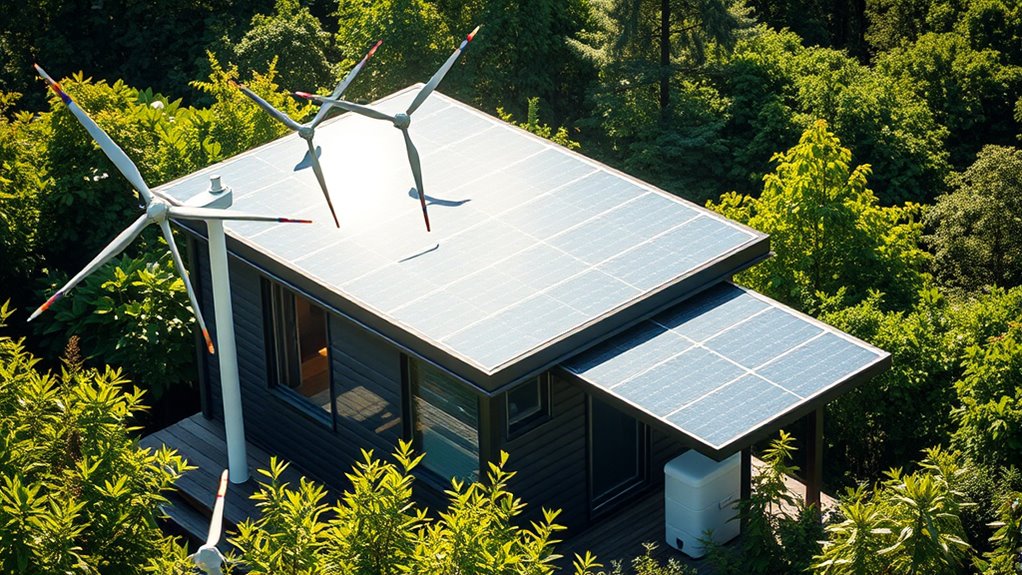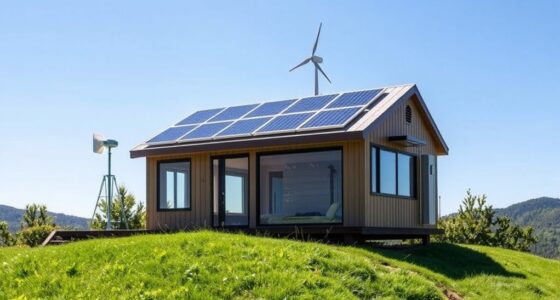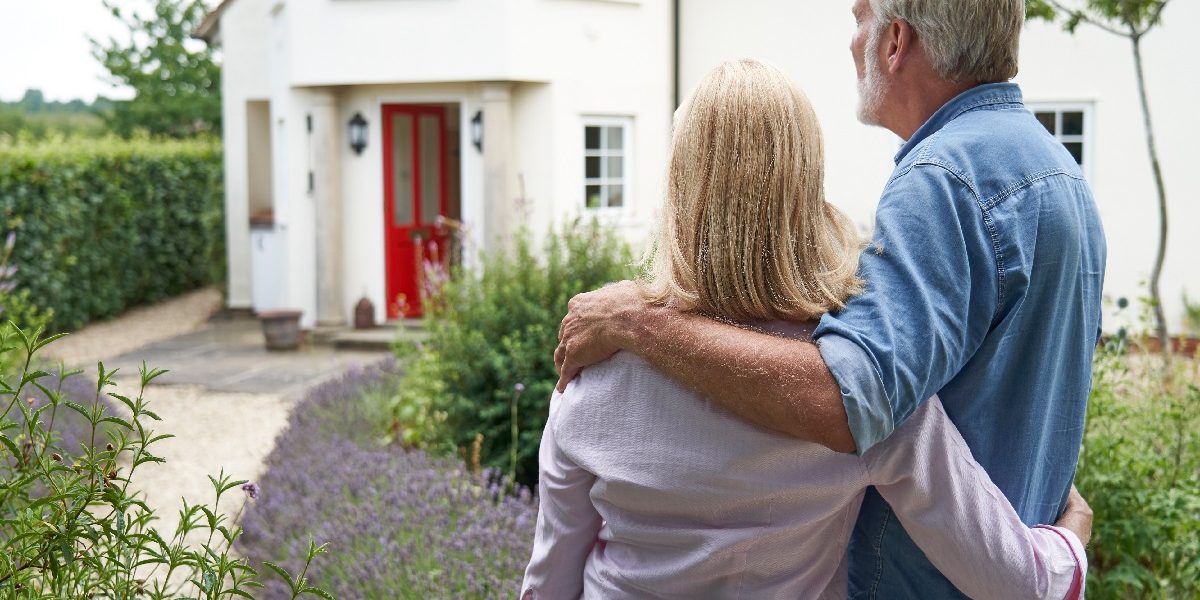To create a net-zero energy tiny home, start by installing high-efficiency solar panels and solar battery storage to generate and store clean power. Incorporate passive design principles like strategic window placement, good insulation, and thermal mass to reduce energy needs. Use energy-efficient appliances and compact furniture to lower consumption. By combining solar tech with thoughtful design, you’ll maximize energy efficiency and sustainability. Keep exploring to discover detailed steps and tips for building your ideal net-zero tiny home.
Key Takeaways
- Integrate high-efficiency solar panels and battery storage to generate and store renewable energy.
- Design passive solar features like optimized window placement and thermal mass for natural heating and cooling.
- Use sustainable, high-performance insulation and energy-efficient appliances to reduce overall energy demand.
- Combine solar systems with passive design strategies to minimize energy consumption and system size.
- Prioritize holistic, ground-up design to ensure seamless integration of technologies for a balanced net-zero profile.

Creating net-zero energy tiny homes is an innovative way to reduce your environmental impact while enjoying a comfortable, sustainable lifestyle. Achieving this goal starts with thoughtful design and strategic integration of renewable energy sources. Solar integration plays a central role, allowing you to harness the sun’s power to meet your energy needs. By installing high-efficiency solar panels on your tiny home’s roof, you generate clean electricity that offsets your consumption. Opt for panels that maximize efficiency given your roof’s orientation and shading, ensuring you capture as much sunlight as possible throughout the year. Incorporate a solar battery storage system to store excess energy, providing power during cloudy days or at night, further reducing reliance on the grid. This seamless integration of solar technology is critical for maintaining a net-zero balance.
Equally important is passive design, which minimizes energy use by optimizing the tiny home’s natural environment. Passive design principles include strategic placement of windows to maximize daylight and passive solar heating, reducing the need for artificial lighting and heating. Position your tiny home to take advantage of seasonal sun angles, ensuring that the sun warms your space in winter and is shaded in summer. Use high-quality, insulated windows and walls to prevent heat loss, maintaining comfort without excessive energy consumption. Incorporate thermal mass materials like concrete or stone inside the home to absorb and slowly release heat, stabilizing indoor temperatures naturally. Proper ventilation is another key element; natural airflow and cross-ventilation keep your tiny home cool in summer and fresh year-round, reducing the need for energy-intensive cooling systems. Additionally, implementing energy-efficient appliances further reduces your overall energy demand and enhances your tiny home’s sustainability.
Combining solar integration with passive design creates a synergistic approach that maximizes energy efficiency. Passive strategies reduce your overall energy demand, making it easier for your solar system to cover your needs entirely. This reduces the size and cost of your solar installation, making net-zero achievable and more affordable. Remember, the goal is to design your tiny home from the ground up with energy efficiency in mind—every detail counts. Use sustainable, high-performance insulation, choose energy-efficient appliances, and consider compact, multi-functional furniture to minimize energy use further. With careful planning, your tiny home can produce as much energy as it consumes, leading to a truly net-zero lifestyle. This approach not only benefits the environment but also creates a more resilient, cost-effective, and comfortable living space for you.
Frequently Asked Questions
What Are the Main Costs Involved in Building a Net-Zero Tiny Home?
The main costs involved in building a net-zero tiny home include material costs and cost estimation for energy-efficient components. You’ll spend on sustainable insulation, solar panels, high-efficiency appliances, and energy storage systems. Accurate cost estimation helps you budget effectively. While upfront expenses may be higher, these investments reduce long-term energy bills. You also need to take into account permits and labor costs, but focusing on quality materials ensures your tiny home remains energy-efficient and cost-effective over time.
How Long Does It Typically Take to Design and Build One?
You’ll typically spend 3 to 6 months on the design process for your net-zero tiny home, depending on complexity. During this time, you’ll carefully select sustainable materials that optimize energy efficiency. This process involves balancing aesthetics, functionality, and eco-friendliness. With the right planning, your project can move smoothly, allowing you to enjoy your personalized, energy-efficient tiny home sooner rather than later.
Are There Government Incentives or Rebates Available for Net-Zero Tiny Homes?
Yes, you can access government grants and tax credits when building net-zero tiny homes. These incentives are designed to encourage sustainable living and renewable energy use. You should explore federal, state, or local programs that offer rebates for solar panel installation, energy-efficient appliances, or eco-friendly building materials. By taking advantage of these incentives, you can profoundly reduce your overall costs and make your net-zero tiny home more affordable.
What Are the Most Effective Renewable Energy Sources for Tiny Homes?
Imagine powering your tiny home with the sun and wind, transforming it into a renewable energy fortress. Solar panels are your best bet, capturing sunlight efficiently and providing ample energy, even on cloudy days. Wind turbines, though smaller, can supplement power in breezy locations, making them a dynamic duo. Combining these sources guarantees you maximize energy production, reduce reliance on the grid, and create a truly sustainable, net-zero tiny home.
How Do I Ensure My Tiny Home Complies With Local Building Codes?
To guarantee your tiny home complies with local building codes, start by researching zoning regulations in your area, as they dictate where tiny homes are permitted. Then, apply for necessary building permits before construction begins. Work closely with local authorities, submit detailed plans, and follow all guidelines to avoid violations. Staying informed and proactive helps you meet legal requirements and ensures your tiny home is safe, legal, and ready to enjoy.
Conclusion
By building a net-zero energy tiny home, you’re not just saving money—you’re revolutionizing the future of housing! Imagine living in a home that produces all the energy you need, making utility bills vanish and your carbon footprint shrink to almost nothing. It’s like having a magic power to sustain yourself and the planet simultaneously. So go ahead, create your tiny home masterpiece—because with this, you’re basically turning into a superhero of sustainability!









